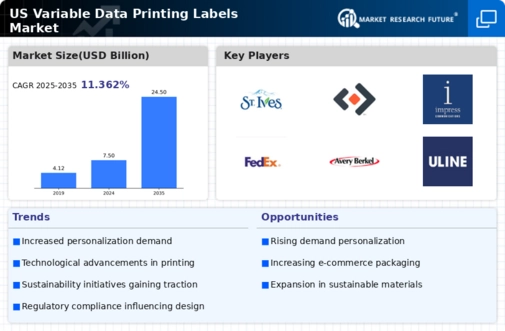Rising Demand for Custom Labels
The variable data-printing-labels market experiences a notable surge in demand for custom labels across various sectors. Industries such as food and beverage, pharmaceuticals, and retail increasingly require labels that can be tailored to specific product needs. This trend is driven by consumer preferences for personalized products, which has led to a projected growth rate of approximately 8% annually in the variable data-printing-labels market. Companies are investing in advanced printing technologies to meet these demands, enhancing their ability to produce high-quality, customized labels efficiently. As a result, the market is likely to expand, with businesses recognizing the value of unique labeling solutions that cater to individual customer preferences.
E-commerce Growth and Packaging Needs
The rapid expansion of e-commerce is a significant driver for the variable data-printing-labels market. As online shopping continues to gain traction, businesses require efficient labeling solutions for packaging and shipping. This demand is particularly pronounced in sectors such as retail and consumer goods, where accurate and appealing labels are essential for customer satisfaction. The variable data-printing-labels market is projected to grow as companies seek to enhance their packaging strategies, ensuring that labels are not only functional but also visually appealing. This trend may lead to an increase in market value, with estimates suggesting a growth rate of approximately 9% in the coming years.
Consumer Awareness and Brand Transparency
Increasing consumer awareness regarding product ingredients and sourcing is influencing the variable data-printing-labels market. Shoppers are becoming more discerning, often seeking transparency in labeling to make informed purchasing decisions. This trend compels brands to adopt variable data printing technologies that allow for detailed and accurate information on labels. As a result, companies are likely to invest in innovative labeling solutions that communicate brand values and product authenticity. The variable data-printing-labels market may experience growth as businesses respond to this demand for transparency, potentially leading to a market expansion of around 6% annually.
Technological Integration in Supply Chains
The integration of advanced technologies into supply chains is reshaping the variable data-printing-labels market. Companies are increasingly adopting automation and data analytics to streamline their labeling processes, which enhances efficiency and reduces operational costs. This trend is particularly evident in industries such as logistics and manufacturing, where accurate labeling is crucial for inventory management and product tracking. The market is likely to benefit from this technological shift, as businesses recognize the potential for improved accuracy and reduced errors in labeling. As a result, the variable data-printing-labels market is expected to see a compound annual growth rate of around 7% over the next few years, driven by these innovations..
Regulatory Compliance and Labeling Standards
The variable data-printing-labels market is significantly influenced by the need for compliance with regulatory standards. Various industries, particularly pharmaceuticals and food, are subject to stringent labeling regulations that mandate accurate and clear information on product labels. This necessity drives companies to adopt variable data printing technologies that ensure compliance while maintaining high-quality standards. The market is projected to grow as businesses invest in solutions that facilitate adherence to these regulations, which can vary by state and product type. Consequently, the demand for variable data-printing-labels is expected to rise, as companies seek to avoid penalties and enhance consumer trust through transparent labeling practices.




















Leave a Comment